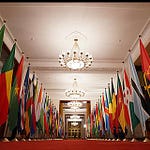As the 15th Conference of the Contracting Parties to the Ramsar Convention (COP15) unfolds in Victoria Falls, Zimbabwe, the spotlight turns to the urgent need for global wetland protection, and to the growing cooperation between China and African nations.
Wetlands are disappearing at an alarming rate, three times faster than forests globally.
This trend has raised concern in many parts of the world, including Africa, where wetland degradation is on the rise.
At the same time, China has made notable progress, recording a net increase in wetland area thanks to sustained investments in ecological restoration and legislation.
As Zimbabwe hosts COP15, what priorities and targets should Zimbabwe, Africa, and China, set to protect wetlands and promote environmental sustainability for a shared future?
Lei Guangchun, Vice Chair of the National Wetland Science Committee and Board Chair of the Shenzhen Mangrove Conservation Foundation, and Anthony Phiri, Director of Environmental Management, Renewable Energy, and Climate Center at Zimbabwe’s Harare Institute of Technology share their insights.
Wetlands under threat
Across the African continent, wetlands are under increasing pressure from human activity, institutional gaps, and environmental shocks.
Rapid urbanization has led to informal settlements and infrastructure being built on wetlands, often without environmental safeguards.
Mining operations have disturbed wetland hydrology and caused heavy metal pollution.
Climate variability, including prolonged droughts and erratic rainfall, has altered wetland ecosystems and reduced water availability.
Lack of enforcement and weak coordination between local authorities and environmental agencies often result in unregulated development.
In Zimbabwe, Lake Chivero, the primary water source for Harare, has seen deteriorating quality due to untreated runoff and the destruction of natural filtration wetlands.
“If the degradation continues, we may soon reach a point of no return—losing wetlands, biodiversity, and even food and water security,” warned Phiri.
Actions underway
Zimbabwe has designated seven Ramsar sites, including the iconic Victoria Falls.
The Environmental Management Agency (EMA) has launched radio campaigns and demarcated wetland protection zones.
Institutes like HIT have partnered with EMA to build artificial wetlands and conduct public education programs.
Youth and students are actively involved in field projects and awareness drives.
“We’ve engaged local communities and even built pilot wetlands,” said Phiri.
“The next step is to ensure these solutions are scaled and protected through proper policy and monitoring.”
China-Africa collaboration
As COP15 builds on the Wuhan Declaration in 2022, Chinese and African delegates are emphasizing shared goals.
Technology transfer and green infrastructure
Capacity building and training exchanges
Co-development of conservation strategies
Stronger international financing mechanisms, including green and blue carbon funds
“Our delegation is here not just to share lessons,” said Professor Lei, “but to help forge global consensus and strengthen the role of wetland protection in biodiversity frameworks.”
Looking ahead: A shared agenda for wetland protection
With Africa accounting for 43% of the world’s Ramsar-designated wetland area, the continent is central to the future of global wetland protection. China’s experience offers policy, legal, and technical models that can be adapted to African realities.
“China’s national law gives full legal status to wetlands,” said Lei.
“And public accountability ensures wetlands are not destroyed in silence. These are practices worth sharing.”













Share this post